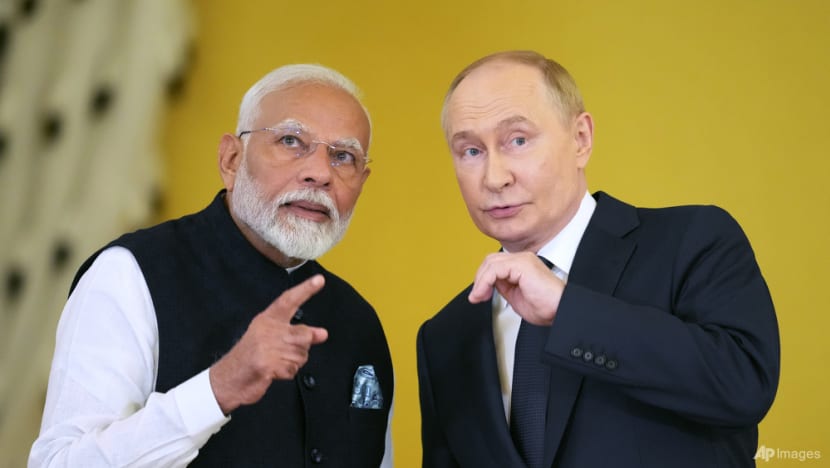Modi’s Russia visit part of larger push for India to be a global power, say observers
Under Prime Minister Narendra Modi, India's foreign policy has become more assertive over the past decade.

Russian President Vladimir Putin, right, and Indian Prime Minister Narendra Modi examine a hall prior to the award ceremony of Narendra Modi with the Order of St. Andrew the Apostle the First-Called in the Kremlin in Moscow, Russia, Tuesday, July 9, 2024. (AP Photo/Alexander Zemlianichenko)

This audio is generated by an AI tool.
NEW DELHI: Indian Prime Minister Narendra Modi’s recent visit to Russia suggests a continuation of his push for India to be a global power, analysts told CNA.
On Tuesday (Jul 9), Mr Modi held talks with Russian President Vladimir Putin amid global outcry over Russian air strikes in Ukraine. It was his first trip to Moscow since Russia invaded Ukraine in February 2022.
Mr Modi, who last month won a rare third term in power, has been credited with elevating India's global presence.
Under him, India's foreign policy has become more assertive over the past decade.
WHEN INDIA SPEAKS, THE WORLD PAYS ATTENTION
"When India speaks at global forums now, the whole world pays rapt attention,” said Mr Modi in May. “When India takes decisions, the world tries to match its steps.”
During his last two terms, India hosted the G20 presidency, started an outreach to countries in the Global South, and became firmly aligned with the United States and western allies.
But India has also maintained its historic ties with Russia.
It abstained from voting in a UN General Assembly resolution that condemned the invasion of Ukraine, and still purchases deeply discounted Russian oil in the face of threats of western sanctions.
Analysts told CNA that this muscular foreign policy approach will persist in Mr Modi's third term.
During the first two terms, Mr Modi focused on creating a space for India to show the world that it can be “a bridging power between the West and the rest”, said foreign policy analyst Shruti Pandalai.
“The idea with Modi 3.0 is going to be continuity.”
ADOPTING A MORE NEUTRAL STANCE
India is not shying away from engaging with Russia, despite the US expressing concerns about military and trade relations between the two sides, said observers.
“India has been careful to adopt a more neutral stance, not siding with the Western countries in cornering Russia,” said former Indian ambassador to the US Meera Shankar.
“Because at the end of the day, if Russia feels itself in a corner, the chances of a negotiated settlement become more remote. So we feel it's important not to have Russia pushed totally into the Chinese basket.”
Some analysts believe Russia is attempting to help India de-escalate tensions with China.
Russia has been pushing the revival of a trilateral dialogue with India and China. But that grouping has not met since 2020, when Indian and Chinese troops were involved in a deadly conflict in eastern Ladakh, sparking a border standoff that remains in place today.
While border differences remain a source of tension between the Asian giants, the appointment of former Indian ambassador to China Vikram Misri as the country's new foreign secretary is seen as a sign that India may be keen to reset bilateral ties.
Recently, India's Foreign Minister S Jaishankar held a rare meeting with China's new envoy to India Xu Feihong, where the two stressed on a common interest in stabilising ties.
INDIA'S GEOPOLITICAL REALITIES
Even as India pitches itself as an alternative to western firms looking to move production lines away from China, it is still heavily import-dependent on its neighbour, with bilateral trade reaching over US$130 billion last year.
Now, more Indian businesses are calling for visa relaxations for skilled Chinese workers. This comes after years of a public campaign calling for a full boycott of Chinese goods and services.
“There's also room for opening up dialogue, and to try and avoid miscalculation,” said Ms Pandalai.
New Delhi is also contending with Beijing muscling in on its neighbourhood.
Last year, the Maldives became the latest country in the region to pivot towards Beijing, after Nepal and Sri Lanka.
Despite the swing, observers said India’s “Neighbourhood First” policy will remain a priority, as shown at Mr Modi's inauguration ceremony in June, which leaders from South Asian countries were invited to attend.
A BRIDGE TO THE WEST
India has also prioritised the West in its engagements, said analysts, highlighting Mr Modi's attendance at the G7 summit in June and the likelihood of fresh trade talks with the European Union and Britain.
The US too, has also sought stronger ties with India, with President Joe Biden calling the relationship the “most defining partnership” of this century.
In the past year, Washington has ramped up weapon sales and technology transfers to India, both to equip it to take on China militarily but also wean it away from traditional military hardware supplier Russia.
Experts, however, warned that a possible return of former US president Donald Trump to the White House following the November presidential election might change trade ties.
















